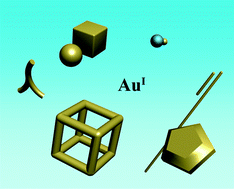AuI: an alternative and potentially better precursor than AuIII for the synthesis of Aunanostructures
Abstract
This article provides an overview of current developments with regard to the use of

* Corresponding authors
a
Department of Biomedical Engineering, Washington University, St. Louis, MO 63130, USA
E-mail:
xia@biomed.wustl.edu
Fax: (+1) 314-935-7448
Tel: (+1) 314-935-8328
b State Key Laboratory for Physical Chemistry of Solid Surfaces, Department of Chemistry, Xiamen University, Xiamen, Fujian 361005, P. R. China
c Department of Materials Science and Engineering, Yonsei University, Seoul, Korea
This article provides an overview of current developments with regard to the use of

 Please wait while we load your content...
Something went wrong. Try again?
Please wait while we load your content...
Something went wrong. Try again?
J. Zeng, Y. Ma, U. Jeong and Y. Xia, J. Mater. Chem., 2010, 20, 2290 DOI: 10.1039/B922571D
To request permission to reproduce material from this article, please go to the Copyright Clearance Center request page.
If you are an author contributing to an RSC publication, you do not need to request permission provided correct acknowledgement is given.
If you are the author of this article, you do not need to request permission to reproduce figures and diagrams provided correct acknowledgement is given. If you want to reproduce the whole article in a third-party publication (excluding your thesis/dissertation for which permission is not required) please go to the Copyright Clearance Center request page.
Read more about how to correctly acknowledge RSC content.
 Fetching data from CrossRef.
Fetching data from CrossRef.
This may take some time to load.
Loading related content
